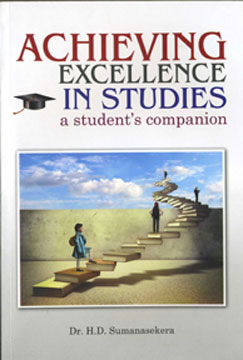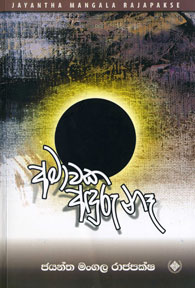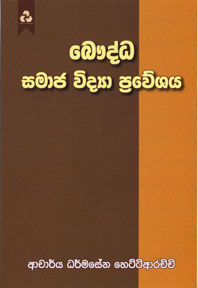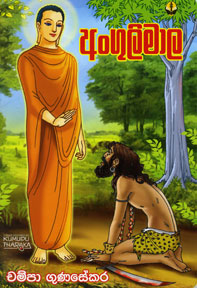|
Books Corner
Segar's overtures to painters
 Segar autobiography with paintings Published by D. Raja Segar Segar autobiography with paintings Published by D. Raja Segar
The arabesque overtures, like in music, seep through his paintings
but the classical genre of his art, lies in the words as found in Segar.
It is a classic the reader will wish to display on his coffee table.
Segar by Segar is unique. It is like a symphony in words that
replaces his ardour. This autobiographical saga is found in a book that
is meticulously printed.
Bestowed upon a strong visual imagination that reveals an
extraordinary wealth of diverse talents, displays a philosophical
development into traditional art. Segar brings out a powerful conviction
in words right from within his heart that makes Segar a sensational
book. He splashes his thoughts within the folds of the pages the same
way he splashes paint on canvas and from it rises brilliant images so
different to many a talented painter/autobiographer. While he stands out
as a singular icon in his paints, he never overestimate himself in his
book.
I see a semblance of the exuberant baroque style of the 17th century.
It is bold and challenging just the way his brush cavorts around
figures. He is a figure artist which is his style, his signature that
art lovers and experts have come to recognise.
Attitude
And Segar the artist remains aloof but Segar the writer has an
attitude and together, they do not confuse the reader nor the art lover.
Segar stepped in at a time when the paucity of cultural and religious
heritage was on the wane though there were who did contribute to
Buddhist theology of painting but they were far and wide, opting most of
the time for nature on canvas which is not Segar's forte. One cannot
blame this situation because Sri Lanka is so full of nature, beautiful,
fresh and burgeoning at her supreme from any angle one looks over.
When I was a student at painting, my eyes and breath only caught on
nature and there was nothing else I wanted to put on canvas which of
course, was wrong. When my teacher took our class outdoor, I would
simply excel on that day. I was able to catch even an erupting bubble so
quickly, if we were on a waterfront. I suppose this is a part of the
wholesome painter. No one can resist nature though Segar was able to.
Thanks to all out painters, big and small, popular and not so-popular
because they are not imbued with any foreign influences. Even the
so-called great impressionists have not left behind any impression on
our painters (though I have seen a few reproductions of foreign Masters
but they are by our novices).
Tradition
As a tradition, our art pivots between nature and the rest via
tradition and tradition and culture which makes Segar one of its
exponents.
However, mythological aura is rampant in his art and shifts between
Indian and Sri Lankan figures. I like the way he paints the Buddha above
all his subjects.
And Segar stands out bold and clear in these themes.
In his autobiography, he traces many points in life and 'Segar' is
clear enough to leave behind a deep impression on the reader.
And Segar stands out bold and clear on his subjects.
As he traces many points in life, Segar leaves a deep impression on
the reader. Written simply, he drives home the depths of the summers he
left behind, into the future in an endearing vibrancy.
He is humble enough to lavish praise on all those who helped him on
to the road of success and his deep family influence in this endeavour
figure out prominently.
At every turn of event, his family had been his source of providing
the climate and sombre moments during his struggle that obviously makes
him an essentially a family man. Excerpt from his book, His story -
'Greenpath was the name of the road where our small house was, though if
faced R.A. De Mel Mawatha, in the heart of Colombo. Our house which had
four common toilets, two for women and the rest for men. These houses
were considered as shanty by our posh neighbourd.
Shanties
"I too thought like that until I saw the Dharavi shanties 20 years
later in Mumbai. My father was a factory labourer at a soft drinks
manufacturing company called Elephant House. When I was four years I
went to stay with my grandparents at Barnes Place in Colombo 7.
"You may think this was a posh house like our Greenpath house. This
house is still there at No.56, Barnes Place. My father was clueless
about my presence, I mean he did not know whether I existed or not. May
be he was overworking.
Unable to get any good school though Royal College was only two
metres away, my grandmother was able to admit me only to St.Michael's
College, a small government school in Colombo 3.'
Long journey
Segar joined the procession in the history of Sri Lankan art in a
long journey that keeps going. The support and exposure given to our
painters abroad is nil which keeps them static and like the wondrous
buds that bloom into flowers fade away.
But painters such as Segar had managed to break away from such
shakels and set up few international galleries especially in Asia which
is only a speck towards development.
In a reflective statement from his book, he says, 'No one can
disappoint me or make me sad by cheating or stealing from me because I
have a powerful weapon given to me by the Buddha Compassion.'
The book is an overture towards our artists that need a massive push
in shaping the development of Sri Lankan artists.
Segar is an overwhelming book by a great artist whose focus is
primarily on Sri Lankan talent.
A must-have book in any library.
- Princess
Vade mecum for students
Reviewed by R.S. Karunaratne
Achieving Excellence in
Studies
Author: Dr H.D.
Sumanasekera
Sumanasekera
Publications,
Nugegoda
 Almost all of us have studied at schools and universities. Even after
securing employment, some of us still remain students learning various
subjects on our own. However, all these years we did not have a
comprehensive guide or a manual for student-centred learning. This
lacuna has been filled by the recent publication of Achieving Excellence
in Studies written by an authority on the subject. The author is a
development evaluation specialist. Almost all of us have studied at schools and universities. Even after
securing employment, some of us still remain students learning various
subjects on our own. However, all these years we did not have a
comprehensive guide or a manual for student-centred learning. This
lacuna has been filled by the recent publication of Achieving Excellence
in Studies written by an authority on the subject. The author is a
development evaluation specialist.
In the preface the author says, "Learning and innovation skills
increasingly are being recognised as those that separate students who
are prepared for a more and more complex life and work environments in
the 21st century, and those who are not moving ahead from 3RSs (Reading,
Writing and Arithmetic).
Within the context of core knowledge instruction, students must also
learn the essential skills such as 4Cs (Creativity, Critical thinking,
Communication and Collaboration) for success in today's world.
Some of us give up learning completely after employment and marriage.
We try to educate our sons and daughters without educating ourselves.
The author points out quite rightly that learning is a life-long
process. As adults we may not be able to follow classes or spend time in
libraries. However, there are modern methods of doing self studies.
Passion
The author has highlighted the fact that we should have a passion for
learning. That is something some of our students lack. They simply want
to pass examinations and secure lucrative jobs. This should not be the
norm. Those who develop a love of learning at an early age will continue
the process throughout their lives. By doing so they will remain
successful, interesting and useful citizens of the country. Throughout
the book the author keeps emphasising this fact.
The present system of education has produced very few intellectuals
because it is teacher-centred. Students depend on the teacher to learn a
subject.
On the contrary, if we adopt a student-centred education system,
students will do research on their own to learn. The author too
advocates student-centred learning which focuses on the student's needs,
abilities, interests and learning style. In such a set up, the teacher
will play the role of a facilitator.
Achieving Excellence in Studies is an excellent book of instructions
for students and teachers. The instructions have been classified into
various topics. The reader will find the book interesting because all
what he wants have been stated in an easy-to-understand capsule form.
The book does not have long mind-boggling paragraphs and chapters.
Everything is systematically presented for the reader's attention.
Information
In 14 chapters the author has presented a wealth of information to
the learner. In chapter 1, he focuses his attention on the importance of
education and knowledge societies. Then he moves on to methods of
learning. He explains the Learning Pyramid and gives 75 ways to learn
faster, deeper and better. The author's account on the benefits of
reading is an eye-opener to most of us.
The author is of the view that failures are quite natural. He cites a
number of successful men in different fields who had failed at first. He
advises parents not to punish children for their examination failures.
His analysis of why children fail is worth paying attention to.
One of the most important chapters is the one on study skills. Most
students are unaware of efficient study skills. He explains the 21st
century study skills lucidly. He also promotes the study of mathematics
and gives useful tips to study it effectively.
Grammar
The author has stressed the importance of learning English
grammatically. He gives 100 ways to learn English and 25 usage
principles for clear writing.
From English he moves on to time management and moral values. He
drives home the point that success in life begins at home. Therefore,
the book can be recommended as a vade mecum (literally,come with me) for
students, teachers and parents.
An autobiography of an entrepreneur
Reviewed by Padma Edirisinghe
Amawaka Anduru Ne
Author: Jayantha
Mangala Rajapakse
Published by Wijesuriya
Grantha Kendraya
 Amawaka night is a familiar sight to Buddhists. The goddess Moon
wanes completely on this night terminating the Pura Paksha and bringing
on the Ava Paksha. Many mothers steeped in Sinhala Buddhist culture opt,
for their children to be born in the Ava Paksha, deemed a lucky phase.
Though the author has highlighted the Amawaka in the title of his last
book, it remains a riddle as to what moon phase he was born in. It is
not clearly asserted. Amawaka night is a familiar sight to Buddhists. The goddess Moon
wanes completely on this night terminating the Pura Paksha and bringing
on the Ava Paksha. Many mothers steeped in Sinhala Buddhist culture opt,
for their children to be born in the Ava Paksha, deemed a lucky phase.
Though the author has highlighted the Amawaka in the title of his last
book, it remains a riddle as to what moon phase he was born in. It is
not clearly asserted.
It is more cogent to the tale told to believe that he had been born
at a time when the moon was waning for the tale he strives to unfold is
one of unflagging endeavour, of a singular rise of a businessman’s life
from dire beginnings. To say hopeless beginnings would be an
exaggeration, for the boy gets born into a certain social and financial
base with a father returned from 2nd World War service and then
installed in the Government service and a mother, a school teacher.
But the boy is certainly ambitious and strives for the stars from his
youth. He seems always to consider inadequate and his eyes are always on
the stars in the sky.
On earth there is a lassie, and the romance between her and him runs
like a silver or golden thread throughout the tale told with a singular
and charming quaintness of its own. The intensity of this love propels
him to dedicate the book, to her.
The book, more or less, belongs to the autobiography genre, now
becoming very popular. When handled by those of the author’s calibre,
they end up as reservoirs of information too. He had been born a few
years after Sri Lanka got her independence, a rather peculiar period
when the shadows of imperialism still linger.
The area he is born and bred, Ambalangoda and Madampe in the Southern
coastal belt through which the Madampe river runs to the ocean, carries
a colonial hegemony covering about 500 years.
This legacy is still stamped on this area via personal names,
religion, many a strange building and even landscapes as carved out by
churches and Christian cemeteries.
They all stand sentinels to its jumbled history of a pure Buddhist
past adulterated by new influences.
One thing we notice about the writer is his non—prejudicial attitude
to the remnants of colonial influence. He does not pause to condemn or
pontificate about them but seems to take it all in his stride, as
inevitable concomitants of the passage of time.
About 500 years ago from the maritime terrain the Portuguese were
driven out by the Dutch who themselves bowed out before the mightier
British power. With a concentrated ambition to rise in the world,
Amawaka or not, the youth does not pause to give judgments on what
happened to the island but is always on the look out to sieve out
chances for his climb.
In the background a coy love affair matures but only via eyes. A
convincing scenario of post–Independence Lanka is presented, the
education system not at all “Systematised” and everything more or less
left to chance and casual happenings in a youth’s life. Child psychology
was unknown in schools. An insight is given to crude situations in
schools when children were subject to humiliating remarks and addresses
such as Gon thakkadiya and Val Booruwa.
Quite a number grew up to actually qualify for these titles while a
few like the author managed to overlook these slights and make headway.
Finally, the writer ends up not only as a very successful entrepreneur
running his own firm in the suburbs of the capital but also as a writer.
The “not so lucky”adventures he undergoes after his entry to the
capital, make not only interesting but rather tedious reading.
It makes the reader wonder as to what will the situation be if all
the successful businessmen in Colombo begin writing their memoirs. Of
course there will be umpteen lessons included for the benefit of the
upcoming youth but along with the didactic element the waning of the
literary element becomes almost inevitable.
Some, very negative-minded will critically state that the book
finally ends up a medley of Parattu or boast, a crowing of the fortunes
of not only the author but also of his offspring. Yet others would in
his defence will argue that according to our main religion, parenting
and being happy and boastful about successful parenting are naturally in
line.
Incidentally, the force of Dhamma empowers the book from the
beginning to the end. And Lady Luck too favours the writer.
Friends and relations volunteer help at the most critical times and
wherever the author emerges, be it here or abroad there is someone to
help him. The romance flowers from the initial eye–contact to a solid
union begetting a happy family too.
Who says Amawaka is dark? The title is not very justifiable unless
the author was born on Amawaka night. Not justifiable too is the truism
attributed to Nelson Mandela that comes at the end. It is, “The greatest
glory lies not in never falling, but in rising everytime we fall”.
Did Jayantha Mangala Rajapakse fall very often? Not many times
according to the long anecdote unfolded in nearly 300 pages. Perhaps
Buddhist philosophy kept the chairman of UNIPOWER, steadily along the
rattled rails of life and earned him good friends while Lady Luck
bestowed on him remarkable opportunities at the correct moments.
Book launch
Bauddha Samaja Vidya Praveshaya

Dr. Dharmasena Hettiarachchi’s latest book Bauddha Samaja Vidya
Praveshaya will be launched at the Dayawansa Jayakody Bookshop, Colombo
10 on November 26 at 10 a.m. It is a Dayawansa Jayakody publication.
New arrivals
Angulimala

Champa Gunasekara’s children’s book Angulimala was launched recently
as a Susara publication. The book comes with apt illustrations.
Arahath Maga Arahath Phala

Thilaka Kudahetti’s latest book Arahath Maga Arahath Phala will be
launched at the Dayawansa Jayakody Bookshop, Colombo 10 on December 3 at
10 a.m.
Arahath Maga Arahath Phala is the Sinhala translation of Ven. Acharya
Maha Boowa Thera’s Arahattamagga Arahatta Phala. It is a Dayawansa
Jayakody publication. |

